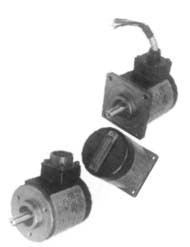TKC50 Single Turn Absolute Encoder
Italsensor TKC50 Absolute Single Turn Shaft Encoder
Mechanical Specifications
Dimensions: see drawings
Shaft: stainless steel
Shaft loading: axial: 200 N; radial 200 N
Shaft rotational speed: 10.000 RPM to short cycle time; 6.000 RPM continuous
Bearings life: 5 x 109 rev. min.
Weight: 0.52 kg
Electrical Specifications
STD codes: GRAY - BINARY - BCD - ANALOG
Output frequency: from 0 to up 20 kHz (L.S.B. without error)
Protection: against inversion of polarity (except 5Vcc)
Materials
Flange: aluminium non corroding
Housing: Aluminium painted with inhibithing treatment 180° C
Environmental Specifications
Operating temperature range: -10°C ÷ +70°C
Storage temperature range: -30°C ÷ 80°C
Relative humidity: 98% RH without condensing
Vibrations: 10 g (From 10 up to 2.000 Hz)
Shock: 20 g (for 11 ms)
<!DOCTYPE html> <html lang="en"> <head> <meta charset="UTF-8"> <meta name="viewport" content="width=device-width, initial-scale=1.0"> <title>FAQ - Italsensor TKC50 Absolute Single Turn Shaft Encoder</title> <style> body { font-family: Arial, sans-serif; margin: 20px; padding: 20px; background-color: #f9f9f9; } .faq-container { max-width: 800px; margin: auto; } .faq-question { background-color: #0073e6; color: white; padding: 15px; margin: 5px 0; border: none; width: 100%; text-align: left; cursor: pointer; font-size: 18px; border-radius: 5px; } .faq-answer { display: none; padding: 15px; background-color: white; border-left: 3px solid #0073e6; border-radius: 5px; margin-bottom: 5px; } </style> </head> <body> <div class="faq-container"> <h2>Frequently Asked Questions</h2> <button class="faq-question">What is the Italsensor TKC50 Absolute Single Turn Shaft Encoder?</button> <div class="faq-answer"> <p>The Italsensor TKC50 is an **absolute single-turn shaft encoder** that provides precise position feedback. It supports multiple output formats, including **Gray, Binary, BCD, and Analog (10-bit resolution).**</p> </div> <button class="faq-question">What is the size of the TKC50 encoder?</button> <div class="faq-answer"> <p>The TKC50 encoder has a **63.5 mm body diameter**, making it suitable for various industrial applications.</p> </div> <button class="faq-question">What output codes are available?</button> <div class="faq-answer"> <p>The encoder supports the following output codes:</p> <ul> <li>**GRAY Code**</li> <li>**Binary Code**</li> <li>**BCD (Binary-Coded Decimal)**</li> <li>**Analog Output (10-bit resolution)**</li> </ul> </div> <button class="faq-question">What are the key mechanical specifications?</button> <div class="faq-answer"> <ul> <li>**Shaft material**: Stainless steel</li> <li>**Shaft loading**: Axial: 200N; Radial: 200N</li> <li>**Rotational speed**: Up to **10,000 RPM (short cycle)** and **6,000 RPM continuous**</li> <li>**Bearings life**: Minimum **5 × 10? revolutions**</li> <li>**Weight**: ~0.52 kg</li> </ul> </div> <button class="faq-question">What materials are used for the housing and flange?</button> <div class="faq-answer"> <p>The encoder is built with **high-quality, non-corroding aluminium** for the flange, while the housing is **aluminium-painted** with an **inhibiting treatment rated up to 180°C** for enhanced durability.</p> </div> <button class="faq-question">What are the electrical specifications?</button> <div class="faq-answer"> <ul> <li>**Standard Codes**: GRAY, Binary, BCD, Analog</li> <li>**Output Frequency**: 0 - 20 kHz (L.S.B. without error)</li> <li>**Polarity Protection**: Built-in (except at **5V DC**)</li> </ul> </div> <button class="faq-question">What is the operating temperature range?</button> <div class="faq-answer"> <p>The encoder operates within a **temperature range of -10°C to +70°C** and can be stored safely at **-30°C to +80°C**.</p> </div> <button class="faq-question">How resistant is the encoder to vibration and shock?</button> <div class="faq-answer"> <ul> <li>**Vibration Resistance**: Up to **10g** (10 - 2000 Hz)</li> <li>**Shock Resistance**: Up to **20g** (for 11 ms)</li> </ul> </div> </div> <script> document.querySelectorAll(".faq-question").forEach(button => { button.addEventListener("click", function() { this.nextElementSibling.style.display = this.nextElementSibling.style.display === "block" ? "none" : "block"; }); }); </script> </body> </html>






